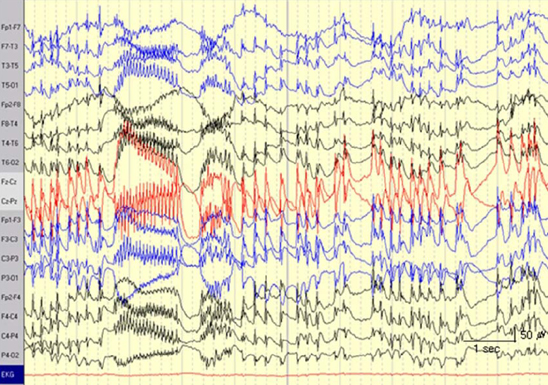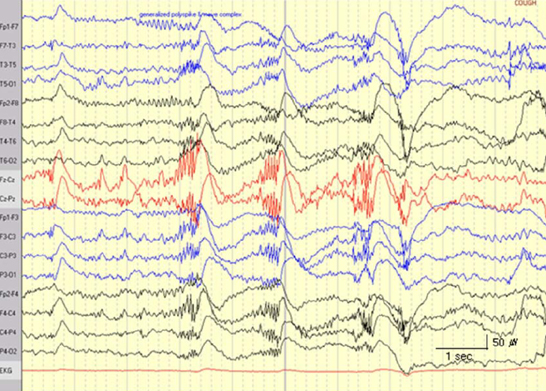J Clin Neurol.
2007 Sep;3(3):154-157. 10.3988/jcn.2007.3.3.154.
A Case of Propofol-Induced Delayed-Onset Refractory Myoclonic Seizures
- Affiliations
-
- 1Department of Neurology, College of Medicine, Dong-A University, Busan, Korea. shkim1@dau.ac.kr
- KMID: 2135495
- DOI: http://doi.org/10.3988/jcn.2007.3.3.154
Abstract
- Propofol, a GABA-mediated inhibitor of excitatory neurotransmitter, is a popular intravenous agent for general anesthesia and sedation. Its side effects reportedly include opisthotonus, seizures, and myoclonus, and are usually manageable. We present a patient who developed propofol-induced delayed-onset refractory myoclonic seizures that resisted antiepileptic drugs.
Keyword
MeSH Terms
Figure
Reference
-
1. Jung SH, Kim TW, Jung KY, Kim JM. A case of propofol-induced seizure-like phenomena. Korean J Epilepsy Soc. 2003. 7:51–53.2. Finley GA, MacManus B, Sampson SE, Fernandez CV, Retallick R. Delayed seizures following sedation with propofol. Can J Anaesth. 1993. 40:863–865.
Article3. Jungheinrich C, Scharpf R, Wargenau M, Dilger C, Bepperling F. Pharmacokinetics of the generic formulation propofol 1% fresenius in comparison with the original formulation (Disoprivan 1%). Clin Drug Investig. 2002. 22:417–427.
Article4. Walder B, Tramer MR, Seeck M. Seizure-like phenomena and propofol: a systematic review. Neurology. 2002. 58:1327–1332.
Article5. Sounders PRI, Harris MNE. Opisthotonus and other unusual neurological sequelae after outpatient anaesthesia. Anaesthesia. 1990. 45:552–557.
Article6. Bevan JC, Veall GRO, Macnab AJ, Ries CR, Marsland C. Midazolam premedication delays recovery after propofol without modifying involuntary movements. Anesth Analg. 1997. 85:50–54.
Article7. Sneyd JR. Excitatory events associated with propofol anaesthesia: a review. J R Soc Med. 1992. 85:288–291.8. Saravanakumar K, Venkatesh P, Bromley P. Delayed onset refractory dystonic movements following propofol anesthesia. Paediatr Anaesth. 2005. 15:597–601.
Article9. Trotter C, Serpell MG. Neurological sequelae in children after prolonged propofol infusion. Anaesthesia. 1992. 47:340–342.
Article10. Borgeat A, Dessibourg C, Popovic V, Meier D, Blanchard M, Schwander D. Propofol and spontaneous movements: an EEG study. Anesthesiology. 1991. 74:24–27.11. Makela JA, Livanainen M, Pieninkeroinen IP, Waltimo O, Lahdensuu M. Seizures associated with propofol anesthesia. Epilepsia. 1993. 34:832–835.
Article12. Campbell GA, Morgan DJ, Kumar K, Crankshaw DP. Extended blood collection period required to define distribution and elimination kinetics of propofol. Br J Clin Pharmacol. 1988. 26:187–190.
Article
- Full Text Links
- Actions
-
Cited
- CITED
-
- Close
- Share
- Similar articles
-
- Myoclonic and Tonic-Clonic Seizures after Propofol Sedation during a Brachial Plexus Block: A case report
- Myoclonic Seizures Occurred during the Brain Tumor Resection in a Patient of the Recurred Malignant Meningioma of Cerebral Frontal Lobe : A case report
- A Case of Severe Myoclonic Epilepsy in Infancy
- Non-Convulsive Status with Myoclonic-Astatic Epilepsy: A Case Repot
- A Case of Convulsive Seizure Development Induced by Clozapine



